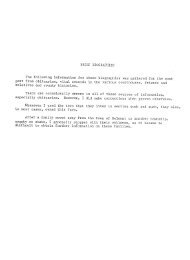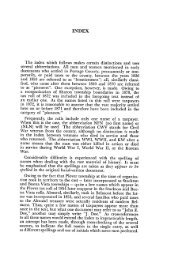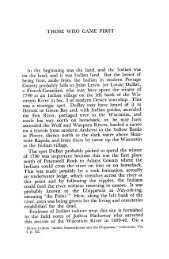ALBAN, THE TOWNSHIP OF Our Country Our Story ... - Library
ALBAN, THE TOWNSHIP OF Our Country Our Story ... - Library
ALBAN, THE TOWNSHIP OF Our Country Our Story ... - Library
You also want an ePaper? Increase the reach of your titles
YUMPU automatically turns print PDFs into web optimized ePapers that Google loves.
<strong>ALBAN</strong>, The Township of<br />
Alban is the only township in Portage County which<br />
can point its finger at the first settler with reasonable certainty.<br />
One of the main reasons for this lies in the fact<br />
that it was the last to be settled and for more than two<br />
decades was administered as part of New Hope. Thus<br />
throug~h the New Hope proceedings it is possible to detect<br />
at once each new settler who paid taxes in the unnamed<br />
township which the Scandinavian pioneers referred<br />
to simply as "bien fern og tieve" (literally: Town<br />
Twenty-five) .<br />
Named after a post office first located near Peru in<br />
New Hope, the township honors the Civil War regimental<br />
commander, James S. Alban, mortally wounded at<br />
Shiloh in the battle of Pittsburgh Landing April 6, 1862.<br />
The circumstances of its location was largely responsible<br />
for the township's late development. Lying in the<br />
extreme northeast of the county, away from the larger<br />
rivers which helped to write the early history of the county,<br />
and away from the railroads which pushed their way<br />
into the county in the 1870s, Alban was further handicapped<br />
by the heavy growth of timber which covered<br />
most of the township. The big lumber companies of<br />
the 1 850s and 1 860s were cutting the timber closer to hand<br />
along the main river systems of the Plover and Wisconsin<br />
and it was not until the lumber companies of Oshkosh<br />
beg~an to exhaust their supply of easy-to-reach timber<br />
along the Wolf River that they began reaching up<br />
the tributaries of the Wolf, especially the Embarrass, and<br />
the Little Wolf which flows through the northeast corner<br />
of Alban into Waupaca County to join the "big" Wolf<br />
near New London.<br />
The subdivision of modern Alban was begun Sept. 28,<br />
1852 and finished Oct. 16, 1852 by Win. P. Huntington,<br />
deputy surveyor.
220 OUR COUNTY OUR STORY<br />
Huntington mentions a "sugar orchard", actually a<br />
camp in the woods, more often referred to locally as a<br />
"sugar bush", where the sap of the hard maple is tapped<br />
and boiled down for maple sirup or for sugar. In the 19th<br />
Century, particularly after the Civil War, sugar was expensive<br />
and at times even difficult to buy. Many pioneers<br />
boiled maple sirup into sugar and sold it or exchanged<br />
for groceries. The sugar camp mentioned by<br />
Huntington, almost certainly operated by the Indians,<br />
was probably located south and east of Lions Lake.<br />
The town of Alban is probably the most favored of<br />
glacial lakes and streams in the county. Slicing through<br />
the northeast corner in Sec 1 runs the Little Wrolf, favorite<br />
of trout fishermen, which drains the Holt Creek<br />
originating in Marathon County, and Bailey Creek which<br />
flows out of spring-fed Lions Lake. The Holt Creek has<br />
also been known as the North Branch of the Little Wrolf,<br />
a name used until well after the turn of the century but<br />
which was subtly changed to Holt Creek after a saw mill<br />
community located in the early 1 900s across the county<br />
line. Some maps refer to Bailey Creek as Bradley, a name<br />
sel~dom heard locally. The origin of either name is uncertain.<br />
A third well-known stream, originating in Sharon and<br />
Marathon County, is known as the South Branch of the<br />
Little Wolf, in opposition to the North Branch, which<br />
runs through the entire township, north to southeast,<br />
via the village of Rosholt. A mill pond was created on<br />
this river in the 1870s by Jens Rasmussen, later taken<br />
over by J. G. Rosholt, and along the west end of this pond<br />
the stumps of the pine that once stood here may still be<br />
noted above and below the water level which add a nostalgic<br />
touch to the natural beauty of the pond.<br />
The largest lake in the township, identified on both<br />
the 1895 and 1915 plats as Helen, in the Historical Atlas<br />
of Wisconsin (1878) is called Hunt Lake, probably after<br />
Huntington. In fact it was known locally after 1900 down<br />
to World War II as Lake Huntington, but since that time<br />
has mysteriously reverted to the name, Helen, probably<br />
after a tavern-bar established by Ambrose Stanislawski on<br />
the north shore. The origin of the name Helen is uncer-
<strong>ALBAN</strong>, <strong>THE</strong> <strong>TOWNSHIP</strong> <strong>OF</strong> 22~1<br />
tamn. According to local legend, a woman by that name<br />
served as a cook in one of the logging camps of Conley or<br />
Ripley 8e Mead in the 1 880s, died, and was buried nearby.<br />
Later, the lumberjacks heard a voice wailing in the wind<br />
along the shores of the lake and recognized it as Helen!<br />
The second largest lake is identified on both the 1895<br />
and 1915 plats as Three Lakes. It lies in Sec 3 and was originally<br />
known as Gutho Lake after the first family to settle<br />
in the northeast of the township in the late 1 860s.<br />
Later plats mistakenly referred to it as "Tree Lake",<br />
probably because the Norwegians pronounced it "t ree"<br />
and the Polish "tree" (for three) and in 1958 it officially<br />
became Tree Lake by action of the County Board. To<br />
the west of Tree Lake a few rods, connected by a small<br />
stream, lies Mlud Lake, favorite of mallards and bluebills<br />
every fall; and to the southeast of Tree Lake, probably<br />
connected by an underground stream, lies Penny Lake,<br />
allegedly named after a dog called Penny owned by Andrew<br />
Nelson who operates a cabin resort on the east<br />
shore of Tree Lake.<br />
In the middle of the township lies Lions Lake, known<br />
locally under several names in the past, but longest as<br />
Kiolbassa, after Peter Kiolbassa, one-time city treasurer<br />
of Chicago who built a summer home on the south shore<br />
in the early 1 890s. The lake property was acquired in<br />
1956 by the Wisconsin Lions Foundation and is now<br />
known as Lions Lake where a summer camp has been<br />
established for visually handicapped children.<br />
Collins Lake, the fourth largest in the township, lies<br />
in the southwest in Sec 31 with the west shore extending<br />
across the range line into Sharon. While it was called<br />
Fish Lake from the 1 870s down to Wrorld Wrar II, it often<br />
came to be referred to as Collins Lake after a county park<br />
was established on the north shore and named in honor<br />
of W. F. Collins of Arnott, one-time County Board chairman.<br />
In 1958 the County Board officially adopted the<br />
name Collins Lake.<br />
One lake which retains much of its primeval charm<br />
lies in the northwest corner of the township in Sec 6 but<br />
'Proceedin7gs, Board of Supervisors, vol. IV, p. 35.
222 OUR COUNTY OUR STORY<br />
has no name, and, as most of the shore line is rimmed by<br />
swamp, is not easy to reach.<br />
Mr. and Mrs. Henry Schritzmeier (or Sckreckzmeier),<br />
Danes from the island of Lolland, were the first settlers<br />
in Alban and were given title to a forty in Sec 35 (the<br />
James Berge place) on Sept. 24, 1857. Several coins<br />
dated in the 1840s and 1850s as well as sherds have been<br />
picked up near this site. In the late 1860s family differences<br />
separated this pioneer couple and while Schritzmeier<br />
returned to Denmark, his wife moved out Wrest.<br />
The first permanent settler in the township of Alban<br />
was either Hans Larson or Hans Klinge (more commonly<br />
Klincke), also Danes. The Klincke cabin stood on the<br />
hillside northeast of the bridge now on Trunk T. Sam<br />
Loken, who eventually acquired this property, found<br />
horseradish still growing near the site when he cultivated<br />
this field. The early Danes were fond of horseradish.<br />
The first Norseman in Alban was probably Ole P.<br />
Klope who is mentioned in the 1865 tax roll as paying<br />
taxes on a forty in the western part of the township.<br />
Whether he had an improvement here or not is uncertain,<br />
but it is known that he built a house, only recently demolished,<br />
which was located in Sec 33 in the southern<br />
part of the township.<br />
The first Polish settler in Alban was Gottlieb Joseph<br />
Liebe who made an entry on three forties in Sec 31 on<br />
Dec. 21, 1863, and paid his first taxes in 1867, one of the<br />
few in the township who acquired land under the Homestead<br />
Act of 1862.<br />
Originally a part of the town of Stevens Point from 1852<br />
to 1856 and from 1856 to 1878 a part of the town of New<br />
Hope, Alban made its first attempt at incorporation in<br />
November 1870 which the County Board rejected. The<br />
matter came up again in November 1877 when the board<br />
voted to constitute a new township to be known "as the<br />
town of Alban, provided that the tax levied upon said<br />
town . .. for the year 1877 shall be levied and collected<br />
by the proper officers of the town of New Hope."' This<br />
is the only time this clause appears in a like order by the<br />
County Board.
<strong>ALBAN</strong>, <strong>THE</strong> <strong>TOWNSHIP</strong> <strong>OF</strong> 223<br />
The first town meeting and election of officers of Alban<br />
was held April 2, 1878, at School District No. 5, actually<br />
a log schoolhouse which stood less than a half a<br />
mile south of Alban Corners (SE-SE, Sec 21). Andrew A.<br />
Brekke was elected chairman; Anton Kirsling and Jens<br />
Rasmussen, supervisors; Martin 0. Wrolstad, clerk; Ole<br />
J. Aass (later Oas), assessor; J. P. Hanson, Jr., treasurer;<br />
C. C. Gilbert, J. H. Bigler, Simen Stenerson, and Andrew<br />
Brekke, justices of the peace; and A. Rasmussen, A. J.<br />
Aass and J. Mortenson, constables.<br />
The 1878 assessment roll, the first in Alban as a township<br />
on its own, includes the names listed below. However,<br />
owing to the fact that Alban was one of the last<br />
townships to be settled, it has been possible, through<br />
family association, to identify, if not all, at least most of<br />
the families which were actually resident in the township<br />
in 1878. These will be italicized as opposed to the others<br />
who presumably represented investors in Alban real estate,<br />
timber or cedar holdings. The taxpayers were: F.<br />
C. Peters, F. R. Land (Fox River Land), Nils R. Bestul,<br />
Andrew A. Brakzke, Berte I. Fijelbo, Aunun A. Brakke,<br />
S. S. Chandler, Ole A. Brakzke, Mark Sutsen, B. H. Wellington,<br />
Olve Ingebretson, Ole C. Seter (probably Sether),<br />
David Boe, John 0. Wraalstad, Andrew Anderson, Ole<br />
P. Linland, Ole G. Flom, Johanes F. Kankrud, Christian<br />
Elingson, Johan 0. Ekkern, Knudt Sakariasan, Margaret<br />
Peterson, Hans 0. Lee, Peter Eiden, John 0. Daabu<br />
(later spelled Dobbe), Gilbert Sc Christenson, John J.<br />
Svanholt, Peter E. Gutu, Thomas 0. Listul, Louis Smith,<br />
Ole P. Hoijord, Edvard Helgesen, Thomas 0. Onland,<br />
Johan C. Kalrud, Hans P. Woldingen, Johan 0. Woldingen,<br />
Nels G. Serkland, Ole P. Kvisla (later Q~uisla), Hans<br />
G. Frogne, Ole P. Daabu, Gunder J. Lia, And (?) Mathison,<br />
Peder 0. Daabu, Ole Paulson, Jacob Semonus<br />
(later Simonis), Amund 0. Hole, Louis H. Foss, Peder<br />
0. Ekeren, Jens P. Hanson, Sr., Hellek 0. Foss, Ole A.<br />
Moe, Ole D. Moe, John Walendalen, Nels Stianson, Jorgen<br />
0. Wraalstad, Ole P. Kiope, Jose ph Liba (later Liebe),<br />
Jose ph Plaska (later Pliska), Frank Lauska, Jens<br />
Rasmuson, John P. Pederson, Jose ph Sabarasky, Jose ph<br />
Clammenzs, Hans G. Hanson, Hans J. Fredrikcson, Ras-
224 OUR COUNTY OUR STORY<br />
mus Jorgenson, Jens P. Hanson, Jr., Anders I. Oas, Ole<br />
I. Qas, Jens Haralson, (later Haroldson), Peder Kystolson,<br />
Charly Pederson, Knu~dt Erickson, Karen Pederson,<br />
Johanes M. Omadt, Cysskleba, Emma Jorgenson, Knudt<br />
Thorson F~ure, Erik Bentzel, Charly Buck, Halvor 0.<br />
Wraalstad, Martin 0. Wralistad, F. Reinharth, Simon<br />
Stenerson, George Laubienten, Andrew Rasmzuson, Thor<br />
Knudtson, Abraham I. Ejelbo, A. H. Bancroft,C. C. Gilbert,<br />
Hans P. Anderson, Elling Johaneson, lens Mortenson,<br />
Paul Anderson, Jacob Jenson, Martin Sarak, Frank<br />
Goytowski, Peder Jorgenson, N. Boyington, Ole G. Bank,<br />
John Zaulauski, Peter Kustus, Jose ph Glodauski, Anton<br />
Kirsling, Apasto Ganyak (?), Jacob Kirsling, Anton Witbrot,<br />
Peder Benson, Frank Gruna, Johanes 0. Byseth,<br />
Wilam Bergen, Hans P. Klinkte, Hans Larson, Nelson Sc<br />
Thomson, Isak Skougen, Janeka N. Smaadal, Johan G.<br />
Skigestad, Peder Johaneson, Henry Wentzel, John H.<br />
Hagemon, Nels 0. Brathovde, John 0. Brathovde, Sven<br />
0. Hagen, Peder K. Heller, Andre N. Hotvedt, and Thor<br />
Amundson.<br />
The post office called Alban, which earlier was located<br />
south of Peru in New Hope, was moved into the town<br />
of Alban in 1880 to the home of Charles C. Gilbert who<br />
lived about half a mile south of Alban Corners (the Frank<br />
Knitter place). Gilbert served as postmaster and later<br />
built and operated a store on his property. The post office<br />
was discontinued in 1905.<br />
Three of the names listed in the 1878 tax roll are mill<br />
owners; namely, Bancroft, Bigler and Wrolstad. All three<br />
mills were located on the south Branch of the Little Wolf<br />
on a three-mile stretch of the river and, from the evidence<br />
of road statements, all appear to have been built in 1867<br />
on the right bank of the river, the farthest upstream in<br />
Sec 33 by Hans 0. Lee Sc Ole Iverson, later taken over<br />
by James Bigler; the second downstream by Ole 0. Wrolstad<br />
in Sec 34; and a third less than a mile farther down<br />
by Willard W. Sherwin, later taken over by the Fleming<br />
and Bancroft families of Amherst who eventually sold out<br />
to Simon Stenerson. The Wrolstad mill was taken over<br />
by son George (Jorgen) in 1881 and later sold to Hans
<strong>ALBAN</strong>, <strong>THE</strong> <strong>TOWNSHIP</strong> <strong>OF</strong> 225<br />
Johnson who operated it until 1903 when the mill<br />
burned.<br />
Between 1875 and 1900 there were probably more logging<br />
operations in Alban than in any township of similar<br />
size in the county. Up from Fond du Lac came Moore and<br />
Galloway's top woodsman, Jack Hunter, to look over the<br />
rapids on the Little Wolf. Owing to the nature of the<br />
rock formations in the river, apparently no one but Hunter<br />
considered the river navigable enough to float a log.<br />
But Hunter brought in ox teams, long power booms<br />
that went with a sweep, and worked the boulders to one<br />
side and those he could not pry out, he blasted with<br />
black powder and piled up along the river bank where<br />
they may still be seen below the Middle Dam in Sec 1.<br />
Hunter built the Middle Dam and a series dams all thne<br />
way to New London in Waupaca County. None was used<br />
for power sites, but rather to create ponds where the<br />
logs could be stored until a "head" had been built up<br />
and then released, sending the logs pell-mell over the dificult<br />
rapids to the next pond farther down.<br />
And up from Oshkosh came cruisers for the Conlee<br />
Lumber Company and Ripley &z Mead to establish logging<br />
camps in the east half of the township, eyeing<br />
the yellow gold in the white pine. All told it is believed<br />
that between 1880 and 1900 Conlee, or "Corn-le"<br />
as the Norwegians pronounced it, had logging camps at<br />
Lake Helen, on the Bailey Creek in Secs 13, 15 and 16, and<br />
between Russell Marsh and Round Marsh in Sec 5, and<br />
on the Little Wolf in Sec 12 not far from the "Improvement<br />
Rapids", more often referred to the "Rips."<br />
All these sites may still be located. The logs from these<br />
camps were hauled by sleigh over swamp roads leading<br />
to the banks of the Little Wolf where they were piled on<br />
skidways pending the spring thaw and then rolled into<br />
the icy water.<br />
Serving the town of Alban, with a population of 682,<br />
in 1957-58, were Harold P. Anderson, chairman; Nick<br />
Wanta and Ed Dziedzik, supervisors; Donald P. Danielson,<br />
clerk; Earl L. Olson, treasurer; Stanley Pliska, assessor;<br />
Donald P. Danielson, justice of the peace; Ambrose<br />
Stanislawski, constable; and Dr. V. A. Benn, health officer.
.<br />
.<br />
.<br />
<strong>Our</strong> <strong>Country</strong> <strong>Our</strong> <strong>Story</strong> Portage County Wisconsin - Link Page<br />
PREVIOUS...<strong>THE</strong> COUNTY BOARD............................................................................203<br />
NEXT.......ALMOND, <strong>THE</strong> <strong>TOWNSHIP</strong> <strong>OF</strong>.....................................................................226<br />
GO BACK TO <strong>THE</strong> ELECTRONIC INDEX PAGE...<br />
<strong>Our</strong> <strong>Country</strong> <strong>Our</strong> <strong>Story</strong> Portage County Wisconsin - Link Page
















